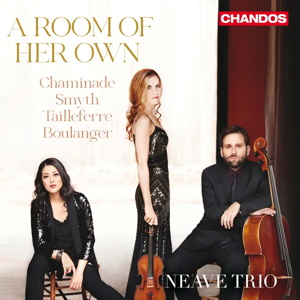
A Room of Her Own
Lili Boulanger (1893-1918)
Deux pièces en trio (1917-18)
Cécile Chaminade (1857-1944)
Piano Trio No.1 in G minor Op.11 (1880)
Germaine Tailleferre (1892-1983)
Piano Trio (1916-17 rev.1978)
Dame Ethel Smyth (1858-1944)
Piano Trio in D minor (1880)
Neave Trio (Anna Williams (violin), Mikhail Veselov (cello), Eri Nakamura (piano))
rec. 2023, Potton Hall, Dunwich, UK
Chandos CHAN20238 [83]
This is a follow up to the Neave Trio’s well received disc of works by female composers Her Voice (review). After recording the first trio by French composer Louise Farrenc they continue with three later French writers, Cécile Chaminade, Lili Boulanger and Germaine Tailleferre. They are coupled with the early trio by Ethel Smyth representing an earlier generation of English composers to Rebecca Clarke who also appeared on the first volume. Chronologically there is a connection; Chaminade and Smyth were almost exact contemporaries while Boulanger and Tailleferre were born in consecutive years though Tailleferre long outlived her unfortunate compatriot.
The disc opens with Boulanger’s Deux pièces en trio which are among the last things she wrote; D’un matin de Printemps is driven and vigorous with violin and cello both playing against a back drop of repeated chords from the piano. D’un soir triste is a complete contrast although the two pieces have thematic links; it opens as a broad, stately sarabande with a long cello melody against the piano’s chordal and increasingly disturbed accompaniment even as the violin joins its voice to the melody. Triste is something of an understatement for this often agonising and heart wrenching piece written in the final years of the first world war and under the shadow of the illness that would end her life before the year was out.
By contrast the piano trio by Tailleferre, written just a couple of years earlier, is a much lighter affair. It began life as a three movement work and was unplayed until 1978 when Tailleferre reworked it into its four movement incarnation in response to a commission. Its lilting first movement, evocatively opening with high sustained Cs from the strings above octaves for the piano, is like Debussy at his sunniest. The second movement was newly written by the 86-year-old composer and is an energetic dance with hints of Poulenc peeping through its sometimes humorous, sometimes acerbic neoclassical textures. The highlight for me is the utterly beautiful moderato third movement, its chordal, hymn-like introduction for the piano developing into a heartfelt duet for the strings and ending with echoes of the blues. The finale is a toccata though with plenty of changes of tempo and mood adding variety.
We travel back to 1880 for the trios of Chaminade and Smyth when both composers were in their early twenties. Both trios are skillful and highly enjoyable with virtuosic writing for all three players. The first movement of Chaminade’s has an easy flowing nature though there is moments of drama; its second theme is a lilting waltz that heads up the development section. The second movement is a beautiful barcarolle-nocturne that centres around a violin/cello duet; an animato section hints at drama to come but any darker clouds are fleeting. The piano takes centre stage in the dazzling scherzo with its coruscating figuration, not surprising to those who are familiar with her solo piano works. The strings are not forgotten; they have their time on the stage while the piano adds a driving but still light textured accompaniment. The finale is a well balanced mix of energetic toccata like and lyrical writing; Chaminade was such a gifted melodist and the whole trio sings, amply attesting to that. Considering her studies under Carl Reinecke and Heinrich von Herzogonberg it is perhaps not suprising that the spirits of Brahms and Schumann hover over Ethel Smyth’s trio from the same year though there is still plenty of individuality and it is clear from the first movement that Smyth understands balance and texture; the mostly pastoral opening pages give way to some dramatic big-boned music and it is through the most delicate writing that the opening music reappears. Smyth’s linguistic abilities may have let her down in the title of the second movement, spelled incorrectly as der Butte der Einfachkeit – the courage of simplicity – but there is no denying her musical gifts in these charming variations based on an original stately minuet. The scherzo has something of a Spanish feel to the piano’s repeated notes – Albéniz’s Asturias comes to mind – but it otherwise inhabits Mendelssohnian territory. The finale’s emotions bounce between brooding intensity, forthright declamation and quiet sentimentality. For all it is somewhat in the shadow of the brighter lights of German romanticism this is an accomplished and really attractive work and not so Teutonic that it sounds out of place alongside its Gallic companions.
Everything here is played with unmannered expression, wit, vivacity and passionate lyricism without heavily laden extravagant gestures and the recording captures the warmth of the trio’s sound marvellously. I am delighted to get to know the Chaminade and the discover the albeit early writing of Ethel Smyth who has previously been pretty much a name in a dictionary but everything here is worthy of the attention and commitment that the Neave trio bring to the task.
Rob Challinor
Help us financially by purchasing from




















